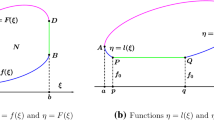Abstract
We study a coplanar model of the successive pursuit of two evaders with unlimited turn rates of the players and a bounded detection domain of a pursuer. Involved in catching the first evader, the pursuer may lose sight of the other. In this case, it must search later for the lost evader in the plane. We describe two guaranteed pursuit strategies obtained as solutions of differential games. Both strategies include a two-stage strategy to shorten to a specified quantity the distance to the nearer evader, and a two-stage strategy to search and capture the other.
The strategies are distinguished by their search plans. First, coalition is pursued as a whole. Then, to minimize an uncertainty index, the pursuer approaches the first evader using the strategy of successive pursuit with the unmoved second evader at its last observed position. Subsequently, the pursuer moves directly to that position of the second evader, or according to the more complex plan, alternates between traversing a straight line and arcs of logarithmic spirals. After detection, the remaining evader is captured with the use of a simple pursuit strategy.
The barriers fit the strategies. We call them approximate, since they bound the states where the pursuer succeeds with the guaranteed (but not optimal as in the case of ordinary barriers) strategies. These barriers are surfaces of constant values of a special game of degree. The more complex search plan secures a wider winning area.
Geometrical interpretations and some numerical results for a set of parameters of the game are provided.
Similar content being viewed by others
References
BREAKWELL, J. V., and HAGEDORN, P., Point Capture of Two Evaders in Succession, Journal of Optimization Theory and Applications, Vol. 27,No. 1, pp. 90–97, 1979.
ABRAMYANTS, T. G., MASLOV, E. P., and RUBINOVICH, E. Y., An Elementary Differential Game of Alternate Pursuit, Automation and Remote Control, Vol. 40,No. 8, pp. 1043–1052, 1980.
SHEVCHENKO, I. I., Successive Pursuit, Automation and Remote Control, Vol. 42,No. 11, pp. 1472–1477, 1981.
SHEVCHENKO, I. I., Successive Pursuit of Three Evaders, Automation and Remote Control, Vol. 44,No. 7, pp. 884–889, 1983.
ZENKEVICH, N. A., An Estimate for a Simple Search in a Plane, Vestnik Leningradskogo Universiteta, No. 19, pp. 112–114, 1981 (in Russian).
CHUDNOVSKY, D. V., and CHUDNOVSKY, G. V., Editors, Search Theory, Marcel Dekker, New York, New York, 1988.
ISAACS, R., Differential Games, John Wiley and Sons, New York, New York, 1967.
Author information
Authors and Affiliations
Rights and permissions
About this article
Cite this article
Shevchenko, I. Successive Pursuit with a Bounded Detection Domain. Journal of Optimization Theory and Applications 95, 25–48 (1997). https://doi.org/10.1023/A:1022679210961
Issue Date:
DOI: https://doi.org/10.1023/A:1022679210961




